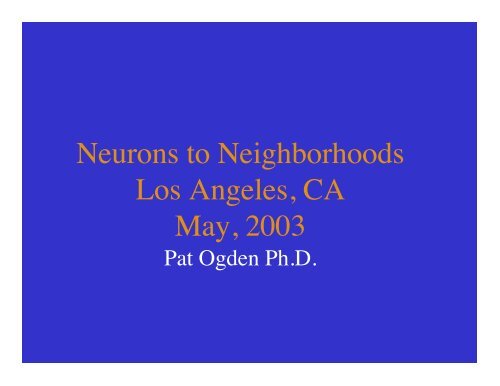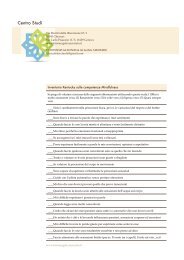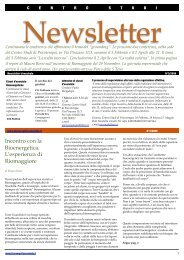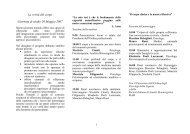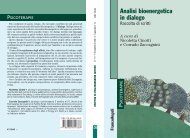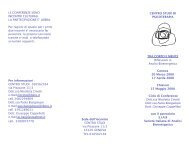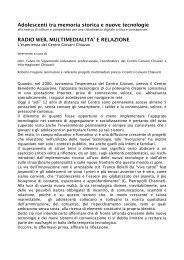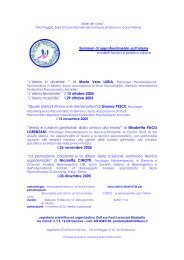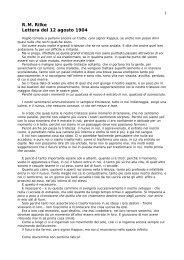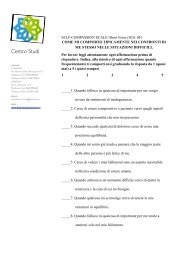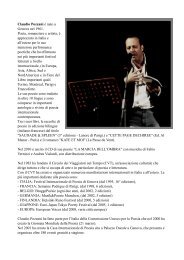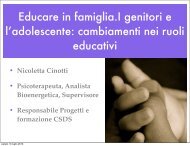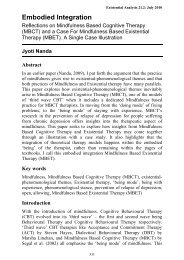Pat Ogden, Ph.D. - Healing Resources
Pat Ogden, Ph.D. - Healing Resources
Pat Ogden, Ph.D. - Healing Resources
- No tags were found...
Create successful ePaper yourself
Turn your PDF publications into a flip-book with our unique Google optimized e-Paper software.
Neurons to NeighborhoodsLos Angeles, CAMay, 2003<strong>Pat</strong> <strong>Ogden</strong> <strong>Ph</strong>.D.
Levels of Information ProcessingCOGNITIVE PROCESSINGConceptual information processing, reasoning, meaning-makingand decision making.EMOTIONAL PROCESSINGExpression and articulation of feeling and affect. Emotionalprocessing adds motivational coloring to sensorimotor andcognitive processing.SENSORIMOTOR PROCESSINGProcessing through the body. Sensorimotor processing involvessensory, physiological and motor sequences associated with thesenses, impulses, movement, postural changes, orientingresponses, physical defensive responses and ANS arousal<strong>Ogden</strong> & Minton, 2000
Sensorimotor Processing…process that organizes sensation from one’s ownbody and from the environment and makes itpossible to use the body effectively within theenvironment. The spatial and temporal aspects ofinputs from different sensory modalities areinterpreted, associated, and unified….The brain mustselect, enhance, inhibit, compare, and associate thesensory information in a flexible, constantlychanging pattern…Ayres, 1989, p. 11
Evaluating SensorimotorProcessingLook at the habits by which a personorients to, registers, organizes, interprets,and acts on information from thesensorimotor systems (sensation,movement, muscles, touch, sight, sound,smell, taste)<strong>Ogden</strong>, 2003
Attuning to the BodyThe therapist must learn to notice and name the physicalpatterns and the moment-by-moment organization ofsensorimotor experience in the client, and teach the clientto do the same:Skin colorQuality of TissueStructurePostureTonicityBreathANS responseFacial expressionVoiceMicromovements <strong>Ogden</strong> 2002
twitchdullsharpachypoundingairysuffocatingtrembleshiverychillsvibrationitchystringyfluidfrozenwarmradiatingshuddernumbflaccidblockedgoose-bumpcongestedheavytightpuffybubblytinglyshakyparalyzedsweatymoistclammyjumblyjerkyenergizedstringydampelectrictight skinlightfuzzydensecoolthrobbingfaintquiverypulsingbloatedflushedpricklybuzzyflutterpressurejumpytensewobblytinglynauseousspinningdizzytremulousbreathlessquakeVocabulary for Sensorimotor Experience(<strong>Ogden</strong>, 1999)
Using Cognition to SupportSensorimotor ProcessingMindfully tracking (following in detail) the sequentialphysical movements and sensations associated withunassimilated sensorimotor reactions to trauma, such as:motor impulses heart rate movements of the spinemuscular tension breathing facial expressiongestures postural changes tremblingVarious other gross motor movements or micro-movements.<strong>Ogden</strong>, 2000
Uncoupling physical sensations from trauma basedemotionsDevelopment and processingof sensation and/or movementInitiation: Thebeginning of sensationand/or movement(inhibit awareness ofemotions, content, etc.)Completion andresolution ofsensation and/ormovement
The Window of ToleranceHigh ArousalAROUSALWindow of ToleranceOptimal Arousal ZoneLow Arousal<strong>Ogden</strong> and Minton (2000)
Bi-<strong>Ph</strong>asic Trauma ResponseHyperarousal:toomuch arousal tointegrateEmotional reactivityHypervigilanceIntrusive imageryObsessive/cyclical cognitive processingTension, shaking, ungrounded.Window of ToleranceOptimal Arousal ZoneHypoarousal:too little arousalto integrate<strong>Ogden</strong> and Minton (2000)Flat affectInability to think clearlyNumbingCollapse
Somatic <strong>Resources</strong>Somatic resources emerge fromphysical experience, but influencepsychological health. They are thephysical actions and capacities thatsupport self regulation and providea sense of well-being, competencyand mastery.<strong>Ogden</strong>, 2002
The Psychology of ActionThe patients who are affected bytraumatic memories have not been ableto perform any of the actionscharacteristic of the stage of triumph[mastery]. They are continually seekingthis joy in action…which flees beforethem as they follow.Janet (1925, p. 669)
Pleasure of the Completed Action[An] important characteristic of the completed action,one we must do our utmost to obtain however difficult itmay be, is pleasure….When an action is beingfunctionally restored…we almost always notice at acertain moment that satisfaction reappears in one form oranother, a sort of joy which gives interest to the action,and replaces the feelings of uselessness, absurdity, andfutility which had formerly troubled the patient inconnection with the action.Janet (1925, p. 988-989)
Self-Regulation:(from Allan Schore)Auto regulation is the ability to self regulatealone without other people. It is the ability tocalm oneself down when arousal rises to theupper limits of the window of tolerance or tostimulate oneself when arousal drops to the lowerlimits.Interactive (psychobiological) regulation involvesthe ability to utilize relationships to mitigatebreaches in the window of tolerance, and tostimulate or calm oneself. <strong>Ogden</strong> 2002
Auto and Interactive Somatic <strong>Resources</strong>•Somatic <strong>Resources</strong> for Interactive RegulationProximityBoundaries and DefenseReaching out, holding on and letting go•Somatic <strong>Resources</strong> for Auto RegulationGroundingAlignmentContainmentCentering<strong>Ogden</strong> 2002
Assessment of Somatic <strong>Resources</strong>•Content: What the patient says about self- regulation;history•Bodyreading: observations of muscular, movement,postural and structural patterns•<strong>Pat</strong>ient's awareness of the body: sensation/tonicity in thearms and legs; sense of alignment/collapse/holding, etc.•<strong>Pat</strong>ient’s awareness of the connection between the bodyand personal psychology•Experiments: conduct somatic experiments<strong>Ogden</strong> 2002
Building Somatic <strong>Resources</strong>1. EducationTeaching patients about structural and movement patterns2. AwarenessAsking patients to be aware of inner body sensation, muscular, postural, andstructural patterns3. ExperimentsTrying out different movements, gestures, and physical organization.4. MirroringThe therapist mirrors the patient’s body posture, structure, or movement.5. ModelingThe therapist physically demonstrates somatic resources6. PracticeThe patient repeats the actions of somatic resources with therapist and others<strong>Ogden</strong>, 2002
Somatic Trauma ResponsesSocial Engagement System (ventral vagal system)facial muscles, eyes, larynx, middle ear; adaptive movementAttachment for Survival:voice, movement toward safe personFlightmovement away from source of threat to potential safetyFreezestiffening type of immobility, shallow, fast breathing, tense musclesFightmovement toward the threat; aggressive actionSubmissionlimp type of immobility<strong>Ogden</strong> 2002, adapted from E. Nijenhuis; S. Porges
Facilitating Sensorimotor Processing1. The patient is taught to be aware of habitualmovements, postures, or structural patterns, and topractice alternatives to these patterns.2. The patient is taught to observes and track innerbody sensation until the movement of sensationand physical impulses until the sensations andimpulses have stabilized.3. “Little experiments” are conducted to discover apatient’s automatic patterns of organization.<strong>Ogden</strong> & Minton, 2000
Teaching Mindfulness ofSensorimotor ExperienceThe therapist asks questions that require mindfulnessof the body to answer:What do you feel in your body?Where exactly do you experience tension?What happens next when your hand makes a fist?What movement does your body want to make?Can you describe the qualities of the tension?What sensation do you feel in your legs right now?<strong>Ogden</strong> 2000
Dissociation in PTSD (1)PTSD has been classically seen as abiphasic disorder with persons alternatelyexperiencing phases of intrusion andnumbing. The intrusive phase isassociated with recurrent and distressingrecollections in thoughts or dreams, aswell as reliving the events in flashbacks.The numbing phase is associated withefforts to avoid thoughts or feelingsassociated with the trauma, emotionalconstriction, and social withdrawal.J.A. Chu (1998, p. 33)
Prediction of Somatoform Dissociation: Jane• duration and age of onset of bodily threat: Jane waskidnapped and raped repeatedly with a gun at age 4/5 for 5 months• interpersonal trauma severity: prior to the actual abuse, Jane’sfather described in detail what would happen to her when the gunwent off• bodily threat from a person: Jane’s father was the perpetrator• lack of adequate parenting and emotional support maypromote integrative failure: Jane’s father told her that hermother was dead; when Jane was returned to her mother, she neverspoke of the abuse because her mother would “dissolve into tearsand leave”
<strong>Ph</strong>ase-Oriented Treatment Approachbased on Pierre Janet (1898)• PHASE 1: SYMPTOM REDUCTIONAND STABILIZATION• PHASE 2: TREATMENT OFTRAUMATIC MEMORY• PHASE 3: PERSONALITYINTEGRATION (limiting belief systems, socialreconnection, relationship and intimacy, life issues, risktaking,change)23
Integrating top-down and bottom-upAddresses cognitive processingwhich, in turn, facilitatessensorimotor processing•uses cognition as a primaryentry point in therapy•identifies and changescognitive distortions•linguistic sense of self•understanding and meaningmaking•formulating a narrativeapproachesAddresses sensorimotor processingwhich, in turn, facilitates cognitiveprocessing•uses the body as a primary entrypoint in therapy•identifies and changes physicalpatterns•somatic sense of self•how the body processesinformation and affects meaning•appropriate integrating narrativewith somatic sense of self<strong>Ogden</strong> 2002


